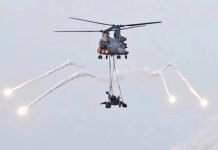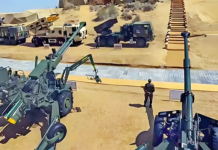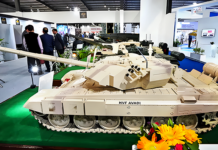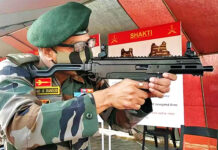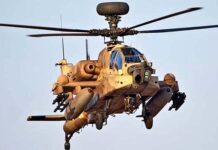Indian Battlefield Management System (BMS) was one of the command, control, communications, computers & intelligence (C4I) projects undertaken by the Directorate General of Information Systems (DGIS) to fill the void of an effective Command & Control (C2) system at battalion/ combat group level. On the lines of BMS of other leading world armies, it was also conceptualised to comprise of a tactical computer at Battle Group HQ and combat vehicles and a tactical hand-held computer with every soldier. The system was envisaged to generate common operational picture by integrating use of high rate data exchange using software defined radios, geographical information system and global positioning system (GPS). The system was planned to have four variants with one each for:-
• Infantry battalion group.
• Armour combat group.
• Mechanised infantry combat group.
• Special Forces.
The BMS approach paper was floated in early 2000. It was envisaged to have development trials and General Staff (GS) evaluation in 2008-2009, before being fielded in the Army during 2013-2017. The project suffered inordinate delays due to various reasons. Expression of Interest (EoI) was issued in February 2015 to 14 domestic companies. Finally, two consortiums – Tata Power SED-L&T and BEL-Rolta India – were selected as development agencies (DA) to develop competing versions of BMS.
The BMS project was one of the only three ‘Make’ category platforms that India’s defence industry has been asked to develop. Under this category the defence ministry was to reimburse 80 per cent of the development costs. In 2016, it was envisaged that procurement of 600 sets of BMS for the Army could generate Rs 40 to 50 thousand crores worth of business.
BMS – A System of Systems
BMS is a third-generation warfare system, which is intended to be used at the level of battalion and below between commanders and individual soldiers or crew. For commanders, it is expected to assist them in exercising C2, quick dissemination of common tactical picture, quick reports to emerging situations, target acquisition, target engagement, avoidance of fratricide along with management of real time logistics. For a soldier, it is supposed to help him in achieving improved situational awareness by answering basic questions like where am I? Where are my assets/ buddy? What is their status? Where is the enemy? What is the type of threat? BMS is not meant to be just another communication system, but will provide commanders at all levels with battlefield solutions.
BMS primarily consists of following three sub-systems:-
• Sensor Sub-system. This sub-system collects all possible information from the field using different electro optical sensors, electromagnetic sensors, GPS, LASER range finders and array of other sensors.
• Communication Sub-system. Communication sub-system consists of a set of digital software defined radios integrated in a mesh type of network, exchanging encrypted information in user-friendly formats (voice, text, data) over varied frequency bands, which are nearly impossible to jam or crack.
• Tactical Combat Computer Sub-system. This sub-system includes ruggedized tactical computers carried by all commanders, crew/ vehicles or individual soldiers. The size and shape of tactical computer depends on the type of use. In case of a dismounted soldier it may be a small hand-held device akin to a smartphone. It will run custom software over a geographic information system (GIS) platform. The computer not only collects and collates the data but also prioritises information of immediate nature to display it urgently over the rest.
Tac C4I Systems
BMS development programme was one of the C4I systems being developed under DGIS to provide C4I solutions from strategic to tactical level. Presently, the key C4I systems being developed in India for different users in the Armed Forces are as given below:-
• Artillery Combat Command Control System. Artillery Combat Command Control System (ACCCS) called “Shakti” is the first among various combat, command, control and information systems being fielded in the Indian Army. It is a network of military grade tactical computers, automating and providing decisions support for all operational aspects of Artillery functions form the Corps down to a battery level. The system is being jointly developed by Bharat Electrical Limited (BEL), Bangalore, Centre for Artificial Intelligence and Robotics (CAIR), Armament Research and Development Establishment (ARDE) and Project Management Organisation (PMO) ACCCS of DGIS.
• Battlefield Surveillance System (BSS). Indian Battlefield surveillance system called ‘Sanjay’ aims to integrate surveillance sensors from Brigade, Division to Corps level. The system uses customized GIS with multi-sensor data fusion aimed at providing inputs to the Command Information and Decision Support System (CIDSS). The system is being jointly developed by BEL in collaboration with CAIR and PMO BSS of DGIS. A test bed of the system has been completed and presently operational validation is under progress, though the system is running behind schedule by many years.
• Command Information and Decision Support System (CIDSS). CIDSS named ‘Samvahak’ being developed by BEL for the Indian Army is supposed to be the nucleus and hub center of Tactical C4I systems. The system is primarily meant for collecting, filtering, processing, formatting and displaying operational intelligence and logistic information for the commanders at all levels in a field formation. This aims at enabling the commanders for better assessment of the battlefield scenario resulting into appropriate decisions. The CIDSS architecture is envisaged to be spread over a Corps Zone comprising of one corps, three divisions, nine brigades, and twenty seven battalions. It is supposed to meet both peace and war time requirements. The system has been plagued by issues of integration and development of application software.
• Air Defence Control & Reporting System (ADC & RS) (Akashteer). This system is being developed by BEL under DGIS. Akashteer is envisaged for tactical command and control of Army Air Defence. It is expected to support automated means to organise, store, process, integrate and transmit the information required for tactical air defence by the commanders. It is designed to provide linkage from firing platform level to the highest level of Army Air Defence control facility. It will act as a force multiplier by providing dedicated high volume voice and data exchange throughout the network in real time, thereby increasing the capability of Army Air Defence. Once fielded, it will not only make engagement of enemy air assets more efficient but will also help in reducing danger to own aerial assets form mistaken identity, which is a real challenge being forced by Air Defence world over.
• Combat Management System (CMS). Combat Management System (CMS) is a naval computer system that connects a ship’s sensors, weapons through data link and provides measures to the staff in performing the combat tasks. Main functions include sensor control, sensor data fusion, threat evaluation and weapon control. A CMS for indigenous aircraft carrier (Vikrant) has been developed by Tata Power SED in collaboration with Weapons and Electronics System Engineering Establishment (WESEE) and MARS, Russia. The system was handed over to the Indian Navy in March 2019.
• Coastal Management System (CSS). This system is being developed by BEL to provide comprehensive surveillance solutions for vessels, ports, waterways, high threat-prone assets and offshore facilities. The system uses centralised data fusion of inputs received from multiple radars and other sensors at centralised command center. Collated output is displays over a digital map to provide enhance situational awareness. The system aims at providing advance information regarding possible sub conventional threats from seaboard as well as for marine traffic management.
Essential Functions
Some of the most essential functionalities desired from a BMS are:
• A Common Operating Picture (COP) for informed decision-making.
• Scalable – Infantry battalion HQ down to individual solider level.
• Integration of all sensors.
• Integration of C2 with intelligence, surveillance and reconnaissance (ISR) capabilities.
• Automatic and quick exchange of operational data, mission planning, visualization and full support for plans and orders.
• Overlay creation and management.
• Display automated massages and warnings.
• Interoperable with other C4I systems in higher chain of command.
• User friendly interface common across all C2 applications.
• Use of cognitive communication equipment to ensure optimal selection and use of the best available transmission medium.
• Ensuring safety of information at rest as well as during exchange.
• Easy options for input of data, objects and tactical symbols.
• Facility to carryout terrain and situational analysis.
Project Foreclosed
In July 2018, Ministry of Defence decided to shut down this revolutionary indigenous BMS project. The main reason given was shortage of funds to sustain such a costly programme. The Army decided to use the funds instead to procure more basic weapons like rifles and carbines. However, industry experts pointed out that the calculation of full programme cost based on prototype development costs was not appropriate. Large scale industrial production of the system would have decreased the cost to a large extent.
The concern over foreclosure of BMS project attains even greater importance in view of development being made by India’s immediate neighbours like Pakistan and China in this field. Pakistan is in the process of developing a BMS called Pak-IBMS ‘Rehbar’ and China is also believed to have fielded a BMS in PLA known as ‘Qu Dian’ a few years back. In the battlefields of the 21st Century, lack of a force multiplier like BMS is going to handicap Indian Armed forces severely and some of the important concerns are as follows:
Effect on Planning. BMS is essential because of the number of systems that it will link together and facilitate planning.
• Absence of Battle Field Transparency (BFT) will affect planning of operations.
• Absence of a system, which can assist in identification of own and enemy troops (Force Tracking), especially when the enemy can do so, will put additional pressure on operational planning.
• Availability of suitable and workable data from BMS can assist in bringing out relevant inference for better planning of future operations. Absence of such data will have negative effect on planning of operations.
Effect on Execution. At present operations are being carried out without a BMS in place, but that should change.
• The main function of BMS is to provide COP to all echelons. Its absence will lead to disjoined execution of operational plan.
• Absence of BMS will result in lack of effective integration of surveillance sensors, resulting into poor BFT and information dominance by the enemy. This may also lead to fratricides.
• Indian BMS system was envisaged to integrate with CIDSS system for seamless flow of information till Corps HQ level. Absence of it will lead to opacity at Division and Corps level regarding operational situation at battalion level.
• Troops/ crew operating over difficult terrain during inclement weather conditions will find it difficult for orientation. This will have negative effect on execution of time-critical operations.
• In absence of BMS, fighting units will depend on Tactical Radio Network for passage of battlefield intelligence. This network has challenges of integration and reliability resultant from lack of standardisation of equipment.
Way Forward
Systems like BMS are operational necessity. Closing of indigenous BMS programme will not only negatively affect Indian Army but also it will be detrimental for ‘Make in India’ drive. Moreover, this may further result in reliance on foreign players.
There is an urgent need to review the decision taken by Ministry of Defence with respect to BMS for Indian armed forces and revive the project. Some of the desired measures to ensure an effective BMS are as follows:
• Contemporary Approach. The field of information systems and communications is experiencing rapid technological advancements; one cannot have the archaic procedures and policies for such time sensitive technologies. New, responsive and flexible procedures and policies of acquisition are required to be formulated.
• Systems Approach. This approach must be adopted to identify the root causes of the previous failures to avoid repetition.
• Utilisation of Project Management Tools. Foresight and planning are essential for development such costly and time sensitive projects. Utilisation of project management tools will certainly keep BMS project on track.
• Diversification of Developers. The tendency of over reliance on governmental defence-industrial complex needs to be stymied. This is a major hurdle to the ‘Make in India’ concept. Moreover, this is a major reason for inordinate delays. Indian BMS programme needs to be opened for private Indian firms.
• Aggressive R&D. R&D funds for such projects must be allocated over and above the budget for Indian armed forces. Defence public sector undertakings (DPSUs) must be forced to compete with private firms to bring out the best of the systems.
• Time-bound Approach. BMS is a technology sensitive project. Time bound approach is a must for fielding of system which is contemporary. Hence, the urge for perfection has to be sacrificed to field the first prototype. Subsequently, the project has to be improved upon through an interactive process with an aim to keep the system contemporary while meeting the user satisfaction.
• Inclusive Participation. There is a need to ensure active involvement of the users in the development programme. This will make them committed to the developmental progress. Successful development and induction of 155 mm Dhanush gun system is an apt example of this approach.
• Integrated Approach. BMS must be able to interact with other C4I systems being developed under DGIS. Except the ACCCS System, all other systems are running far behind schedule. All efforts must be made to bring all such projects on to a common cost effective platform for effective integration.
• Achieving Self-reliance. Development of such high end systems will help Indian industry evolve. Indigenous capability in producing cutting edge defence systems will go a long way in reducing India’s dependence on foreign vendors. This will help Indian Industry to foray into lucrative international market, earning valuable foreign currency.
Changing battlefield milieu will certainly demand fielding of BMS for Indian armed forces sooner or later. There is a definite need of decisive goal oriented time-bound pragmatic approach to field this system for benefit of the forces. This is even more relevant because of efforts in this field being invested by major military powers neighbouring India. Acme of mil leadership lies in amassing strength against the weakness of the opponent and strength accrued by a force multiplier like BMS, which not only gives tactical advantage to the troops but also fortifies self-confidence must be realised by the military planners; the sooner, the better.
====================
Maj Gen Kulwant Singh Nijjar is Chief of Staff, HQ 2 Corps





